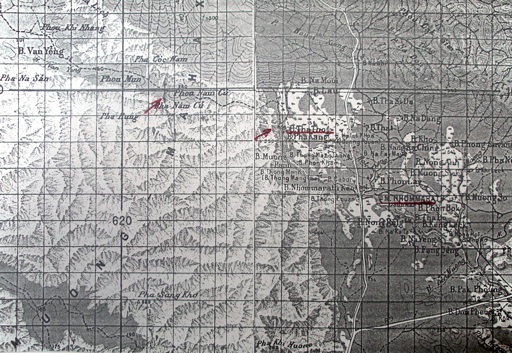Back to “Marie Cassan”

Henri Cassan - 1953
In March 1953, in the heart of the dry season, the Cassan pair returns to Ban Thathot, to check if the upstream sump of "Marie Cassan" is now free of water. Their hope is disappointed, because the cave roof still dives into the wide terminal pool. But much remains to be done; a climb gives access to a fossil network in which Henri spots ants and an un-pigmented scorpion; several kilometres to the west, the team investigates Tham Deua, a sink which probably feeds the "Marie Cassan" river.
The vast decorated chamber gives access to a secondary cave network. After its resurgence, the river flows across a large sinkhole before disappearing again under a wide porch.
For lack of time, the Cassan team could not continue any further their explorations.

The 1:100000 map, annotated by Henri Cassan, where the two red arrows
point toward the Tham Deua and “Marie Cassan”entrances
One year later, the battle of Dien Bien Phu marked the end of the french colonial ambitions and the end of the speleological expeditions in Laos. Henri and Marie will never return to Indochina, but will continue to dream of it.
Their story does not stop here.









Two hours of walking on a highly varied trail seeping through a series of passes in a jungle wedged between rock walls led us to destination. The camp was set up in a sparse forest along the river, a few hundred meters from the cave where it disappeared.
The next morning, at dawn, the inflated boats are launched and hauled until the sink in shallow waters overgrown with aquatic plants. Here the river has worked its way under a horizontal rock layer, which explains the substantially rectangular cross section of the tunnel. The sound of a waterfall comes to us imperceptibly. We sail in a perfect tunnel, that one would believe drilled by man.
Suddenly after a river bend, the darkness is disturbed by a light ray. The long underground trip we were prepared for is already ended ! However, a large cavern appears before our eyes, that, in our disappointment, we observe with no indulgence.
And yet enormous natural wealth have been accumulated here and the inventory of the "room of wonders" and its extensions will far exceed all our expectations.
Cassan H., 1953. A la conquête des dernières terres vierges d’Indochine. Indochine-Sud Est Asiatique, 20, p.23-27.Accueil



